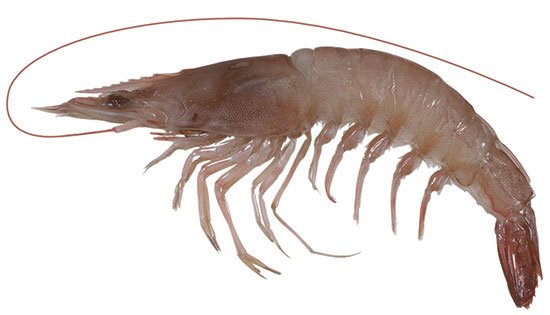Endeavour Prawns
Metapenaeus endeavouri (Blue Endeavour Prawn)
Metapenaeus ensis (Red Endeavour Prawn)

Species
Prawns
Description
Available wild-caught, they are bottom-dwelling marine prawns, found from southern NSW, around the northern coast of Australia to Shark Bay, WA.
Adults are found in coastal waters on sandy or muddy bottoms to depths of about 95m and juveniles usually on seagrass beds in estuaries, although reds can also be found on mud flats and among mangroves. They are caught at night in WA, NT and Queensland by trawlers in rivers, inshore areas and offshore continental shelf waters, with the largest catches coming from the Gulf of Carpentaria.
Blues comprise about half the total prawn catch in Torres Strait. They have a pale brown to pink body with either a bright blue or bright red edge to the tail fin, depending on the species.
Other Names
Bluetail Endeavour, Endeavour Shrimp (Blue); Greasyback Shrimp, Greasyback Prawn, Offshore Greasyback Prawn (Red).
Family
Penaeidae (Penaeid Prawns).
Season
Mainly caught from March to November. NT and WA fisheries are closed December to March, and NT again in July.
Size and Weight
Blues are commonly 22-30g and 7-14cm body length, but can grow to at least 20cm. Reds are generally slightly smaller.
Price
Medium priced.
Relations
Other Metapenaeus species, including Bay Prawns and School Prawns. All Metapenaeus can be sold as School Prawns.
To Buy
Look for brightly coloured, firm, intact, lustrous shells, without any discolouration, particularly at joints, and a pleasant fresh sea smell. Prawns are highly perishable in their raw state and so are often frozen or boiled at sea as soon as they are caught.
If cooking with Prawns, buy green (raw) Prawns, as cooked Prawns will toughen if reheated.
To Store
Leave prawns in their shells until just before using and store them in an airtight container in the refrigerator for up to 3 days or freeze for up to 3 months below -18ºC. Once thawed, frozen Prawns should not be refrozen.
To Cook
Average yield is 45%. Has a sweet flavour, stronger than most other Prawns (sometimes with a slight iodine taste), low-medium oiliness and moist, firm flesh. Their stronger flavour means they are better suited than other Prawns to stronger spicing and seasoning.
Flesh is translucent when raw with white to pinkish bands when cooked. After removing the head from a fresh green Prawn, hold the Prawn straight and gently pull the end of the digestive tract (from the head end), it will usually come out in one go. If it breaks off, use a thin skewer to hook it out from the back, or make a small incision along the back and remove it.
In cooked Prawns, cut the back open to remove the digestive tract. Very small Prawns can be eaten whole, shell and all.
Cooking Methods
Steam, poach, deep-fry, pan-fry, stir-fry, grill, barbecue. The firm flesh holds together well in soups and curries and threaded on skewers for kebabs.
Like all seafood, Prawns require very little cooking. It is always better to undercook, rather than overcook, them, as they will continue to cook in the residual heat once they are removed from the pan.
Cooked Prawns are good in salads and sandwiches, or eaten cold with a dipping sauce, but don’t use them in a cooked dish, as reheating will make them tough.
